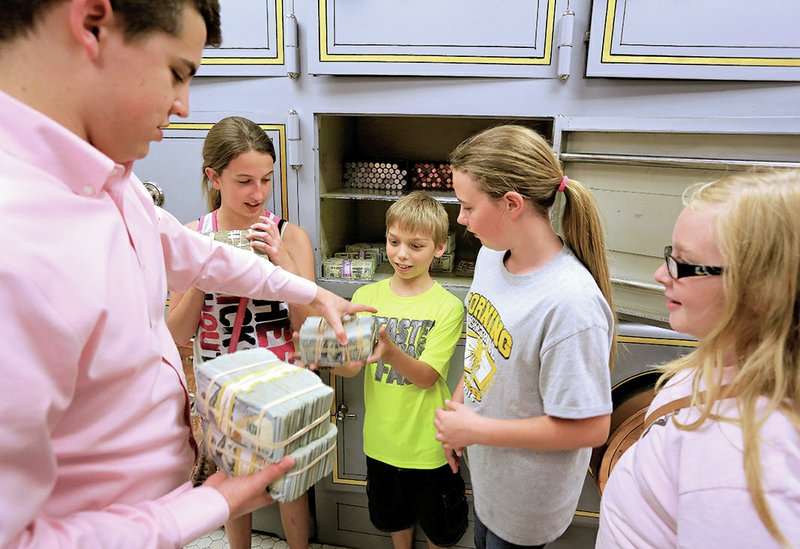They arrive to observe democracy, learn Arkansas history and hold piles of cash.
Thousands of people visit the Capitol each month. They are from every corner of the state and world.
At 2 p.m. Thursday, 50 of those visitors are first-graders at Little Rock Preparatory Academy.
In single file, Jennifer Cleveland, a tour guide, leads the two classes into the Old Supreme Court. The children peep over railings and crane necks to look at the high ceiling on their way up the stairs.
"Welcome to your state Capitol," Cleveland says to start the tour. "Did you know this is your building?"
The first-graders answer all at once. Yeses and noes echo around the room. Janette Dixon, one of four teachers for the two classes, says answering immediately is something they learned in school.
Cleveland starts into the history of the building.
In the 1840s, Arkansas built its first statehouse. By the 1890s, it was falling apart. One day it rained so much the ceiling collapsed on three of the senators, prompting the state to build again.
The Capitol was built on the site of an old prison on the west side of Little Rock. Farms bordered it.
"There was no Chenal Parkway. There was no university," Cleveland says. "Nothing -- just farmland."
The children gasp.
Cleveland talks about how the Legislature affects children. The government now requires each student to learn coding -- just like Facebook's Mark Zuckerberg -- and cursive.
She says Arkansas is unique in many ways. For example, it is the only state where people can keep the diamonds they find in a state park.
"A lot of people who find diamonds are about y'all's size, did you know that?" she says. "Y'all are closer to the ground."
Cleveland asks if there are any questions. About eight hands go up.
Where do the doors go? Why is it so big? Was it built a long time ago?
The doors go to really small closets, a lot of people work here and it was built about 100 years ago, Cleveland says.
The next stop is the rotunda, outside the treasurer's office. The children sit on the floor. Cleveland says sometimes visitors get dizzy staring at the high ceiling and fall down.
The floors are made of marble, but Cleveland wants the students to double-check.
"I want you to feel it. Is it hard?"
"Yes."
"Is it solid?"
Yes."
"Is it cold?"
"Yes!"
The marble is from Vermont. The pillars are from Colorado. The outer limestone came from Arkansas and Indiana. The chandelier was made in New York, and Utah has a matching one. It's 12 feet wide, 16 feet tall and weighs 4,000 pounds -- the same as two elephants.
The children gasp. Weights are expressed in terms of elephants for the rest of the tour.
Cleveland turns to the front doors.
"What color is the Statue of Liberty?" she asks.
"Green," the children respond.
Cleveland says the doors -- which were bought from Tiffany and Co. -- would turn the same color if workers didn't polish them five days a week, three hours a day.
The children walk up another flight of stairs to the House gallery, sitting where members of the press normally would. Rep. Dan Sullivan, R-Jonesboro, sitting at his desk alone in the chamber, waves to the kids from below.
Cleveland explains that senators write legislation that stems from problems within the state. For example, a bill outlawing texting and driving passed earlier this year.
The children say they think texting and driving is a terrible idea.
Cleveland walks the students through a bill of their own. Children would be given $1 per day for attending school but would forfeit the money if they missed more than two days.
The bill passes, but some expressed discontent.
After a quick walk through the Senate gallery, the students head to the treasurer's office.
Tellers Jackson Matayo, Shyreen Hightower and Hunter Hatcher double as tour guides when people visit.
Spokesman Grant Wallace says that's fairly often. More than 200 people stop by every day, making it the most visited office in the building, he said.
The reason for that is simple. Matayo said the 1890 constitution requires the office to hold at least $250,000 in the vault at all times.
"The constitution also says that if anybody comes in and asks to see the money, that we the employees are required to show you the money," he says. "So on the count of three, say 'Show me the money.' One. Two. Three."
"Show me the money!" the children respond.
"So now, by law, I have to show you the money," he says.
Four at a time, children walk behind the tellers' desks. They step through the door -- which weighs more than two full-grown elephants -- into the airtight vault.
Hatcher hands the first-graders stacks of money, carefully wrapped in multiple rubber bands. The stacks of $100 bills contain $100,000.
"Oh my goodness," says one student.
Matayo takes each group's picture and posts it online on Photobucket.
Before getting back on the bus, the first-graders' last stop is on the Capitol's front steps for a group picture.
Kyla Knox, 6, says she's been to the Capitol at least 10 times before. Her mom used to work there, she said.
Her favorite part of the tour? The House and Senate chambers.
"Because I probably just liked seeing it."
Metro on 05/17/2015
